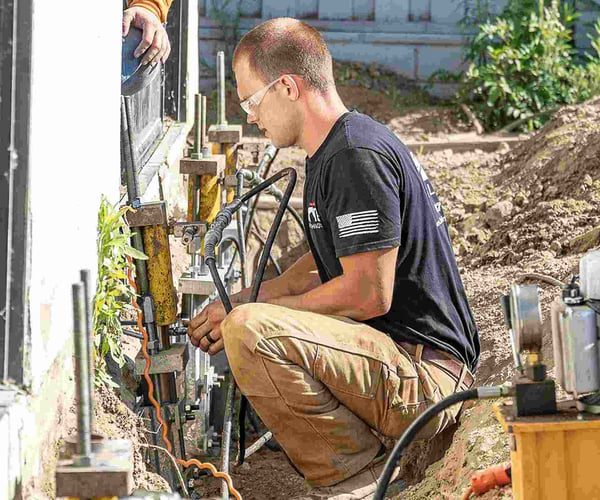Are you trying to decide between concrete pier underpinning or push pier underpinning? Not sure what product will last longer or offer more bang for your buck? If you’re having difficulty deciding between underpinning with concrete piers or push/helical piers, then this article is for you.
Dalinghaus Construction Inc. has been in the foundation repair game since 2015 and we have over 100 years of combined underpinning experience. We’ve seen the stark night-and-day differences between underpinning with concrete piers and underpinning with steel pier systems. We want to help you make the best-educated decision for you and your family.
In this article, you will learn how steel pier systems match up against concrete pier systems in terms of durability, effectiveness, and lifetime warranties.

Is Concrete Pier Underpinning or Steel Pier System Underpinning More Durable & Effective?
In essence, piers are the backbone for all underpinning systems. Piers are generally comprised of cement and rebar or galvanized steel. Piers act as an underground stilt system, extending the depth of a foundation, providing additional structural support, and combating the effects of foundation settlement.
Underpinning systems (regardless of their makeup material) need to be able to do two things:
- Withstand/support an incredible amount of pressure from the structure’s load
- Withstand various weather conditions (from freeze cycles to wet earth) / age well
While concrete piers can withstand the load of a home, when appropriately spaced beneath the structure, they are not durable and have difficulty reaching load-bearing depth, rendering them ineffective.
Concrete piers, however, are relatively cheap due to the readily available composite material – cement and rebar. The low price point is an enticing selling point for these short, squat pillars of cement. When it comes to concrete piers, you get what you pay for.
Concrete is a porous material, like a sponge. Under the right conditions (heavy rains, a busted water pipe, or an overwatered yard), moisture can be sucked up into the porous concrete, rusting the internal rebar. The rust expands, breaking off chunks of the concrete pier and leaving the concrete pier as a useless form of support.
However, for the sake of argument, let’s say that the concrete piers never crack or succumb to water damage. Concrete repair companies often install to what they refer to as “refusal” – meaning the soils are refusing to sink the concrete pier further. Refusal is solely dependent on the strength of the hydraulic system and is not necessarily indicative the concrete piers have reached competent, load-bearing soil.
Eventually, these concrete piers sink and settle into the weak soil, failing to permanently combat the foundation settlement. It’s like throwing an anchor around an already sinking ship – counterproductive.
Note – This is essentially the same issue with slabjacking, mudjacking, and concrete underpinning. Read our article Outdated Methods of Underpinning: Mudjacking & Concrete Piles to learn more.
Concrete Pier Pros –
- Cheap
Concrete Pier Cons –
- Susceptible to water damage (spalling and rusted rebar)
- Inability to reach competent, load-bearing soil
- Weak, with a maximum load capacity of about 8,000 pounds
- No opportunity to lift home to maximum practical recovery
Steel pier systems (push piers and helical piers) can both support the load of a home and withstand various weathering conditions.
Steel pier systems are comprised of inter-fitting steel pipes that are hydraulically driven to competent, load-bearing soil and are anchored to the foundation’s prepped footing via a remedial bracket to secure, stabilize, and/or lift the structure.
Push pier and helical pier underpinning systems are remarkably strong. When utilized every six feet, steel pier systems provide more than enough strength to support your home. Push piers have a maximum load capacity of up to 68 thousand pounds. Helical piers have a maximum load capacity of up to 74 thousand pounds.
Push piers and helical piers are galvanized or powder coated to impede rust and oxidization. In addition, steel pier systems also reach an average of 25 to 30 feet, hitting competent load-bearing soil or bedrock.
Steel Pier System Pros –
- Push pier and helical pier systems are galvanized/waterproof
- Steel pier systems have incredible load-bearing capacities
- Steel pier systems last as long as the structure
- Steel pier systems reach the appropriate depth for load-bearing soil/bedrock
- Steel pier systems allow for lifting to maximum practical recovery
Steel Pier System Cons –
- Steel pier systems cost more than concrete piers
Do Concrete Underpinning Systems or Steel Pier Underpinning Systems Have Better Warranties?
Many foundation repair companies offer no or limited warranties when it comes to concrete pier underpinning.
Dalinghaus Construction Inc., like many underpinning contractors, offers a lifetime warranty on all steel pier systems – push pier, helical pier, and helical tiebacks. The lifetime warranty is transferable upon inheritance or sale/purchase of the home and covers the lifetime of the structure.
What Factors into Foundation Repair Price?
In this article, you learned that concrete underpinning systems are susceptible to water damage, don’t reach competent, load-bearing soil, and often have no warranty. You also learned that push pier and helical pier systems allow for a home lift, withstand weathering, and enjoy lifetime warranties.
Dalinghaus Construction Inc. has serviced hundreds of foundations in Southern California and Arizona. We understand foundation repair, especially underpinning, can prove a costly expense. You may be tempted to go the cheaper route (aka, cement piers), but cheaper is not always better.
To learn about everything that factors into foundation repair cost, read our article Foundation Repair Cost.






